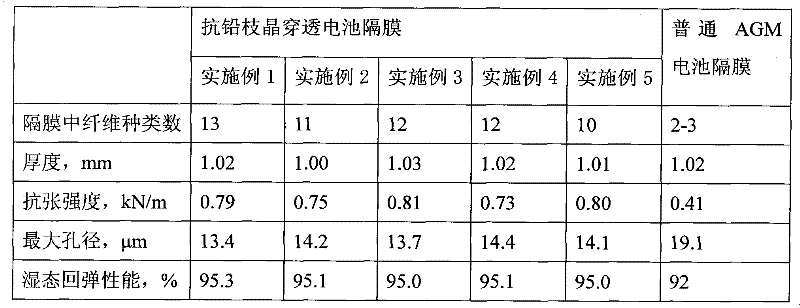Preparation method of battery diaphragm resisting penetration of lead dendritic crystal
A battery separator, glass microfiber technology, applied in battery pack parts, circuits, electrical components, etc., can solve the problems of poor penetration resistance of lead dendrites, affecting battery life, battery short circuit, etc. The effect of discharge, improving cycle life, and slowing growth rate
- Summary
- Abstract
- Description
- Claims
- Application Information
AI Technical Summary
Problems solved by technology
Method used
Image
Examples
Embodiment 1
[0011] Mix 3kg 39°SR high-alkali glass microfiber, 15kg 44°SR high-alkali glass microfiber, 0.5kg 39°SR medium-alkali glass microfiber, 2kg 44°SR medium-alkali glass fiber, 2kg 49°SR medium-alkali glass Fiber, 10kg 54°SR medium-alkali glass microfiber, 0.5kg 59°SR medium-alkali glass microfiber, add water, and disperse with a hydraulic pulper for 6 minutes. Use the thick slurry pump to pump the obtained thick slurry into the tank with about 15m 3 In the first slurry storage tank of the 0.2‰ concentration suspending agent (polyacrylamide) solution, continue to add the above-mentioned 0.2‰ concentration suspending agent (polyacrylamide) solution until the total volume of the slurry in the slurry storage tank is 25m 3 , and continue to disperse for more than 5 minutes with a horizontal mixer to form a uniform first slurry with a concentration of 1.32‰.
[0012] 0.5kg 6μm / 6mm medium alkali glass fiber chopped strands, 0.5kg 9μm / 9mm medium alkali glass fiber chopped strands, 0.5k...
Embodiment 2
[0015] 9kg 39°SR high-alkali glass microfiber, 15kg 44°SR high-alkali glass microfiber, 0.3kg 39°SR medium-alkali glass microfiber, 1.8kg 44°SR medium-alkali glass microfiber, 1.8kg 49°SR medium-alkali Glass microfibers, 4.8kg 54 ° SR medium-alkali glass microfibers, 0.3kg 59 ° SR medium-alkali glass microfibers are dispersed with a hydraulic pulper, and the others are the same as in Example 1, and the final concentration is 1.32‰ The uniform first slurry.
[0016] 1kg 6μm / 6mm medium alkali glass fiber chopped strands, 0.5kg 9μm / 9mm medium alkali glass fiber chopped strands, 0.6kg 6mm / 2.5D PET / PET fibers, 0.4kg 6mm / 2D polypropylene fibers with a Dutch beater For dispersion, the dispersion time is 18min. Others are the same as in Example 1, finally forming a uniform second slurry with a concentration of 0.5‰.
[0017] The homogeneous slurry in the two slurry tanks is at a 10m 3 Mix in the tank at a ratio of 5:1, add water to dilute 2 times, pump to the multi-tube pulp distri...
Embodiment 3
[0019] Mix 5kg 39°SR high alkali glass fiber, 15kg 44°SR high alkali glass fiber, 0.5kg 39°SR medium alkali glass fiber, 2kg 44°SR medium alkali glass fiber, 2kg 49°SR medium alkali glass fiber Fibers, 8kg 54 ° SR medium alkali glass microfibers, 0.5kg 59 ° SR medium alkali glass microfibers were dispersed with a hydraulic pulper, and the others were the same as in Example 1, and finally a uniform slurry with a concentration of 1.32‰ was formed.
[0020] 0.5kg 6μm / 6mm medium alkali glass fiber chopped strands, 0.5kg 9μm / 9mm medium alkali glass fiber chopped strands, 0.625kg6mm / 2.5D PET / PET fibers, 0.5kg 6mm / 2D polypropylene fibers, 0.375kg 6mm / The 2D polyacrylonitrile fibers were dispersed with a Dutch beater, and the dispersion time was 18 minutes. Others are the same as in Example 1, finally forming a uniform slurry with a concentration of 0.5‰.
[0021] The homogeneous slurry in the two slurry tanks is at a 10m 3 Mix in the tank at a ratio of 5:1, add water to dilute 2 t...
PUM
 Login to View More
Login to View More Abstract
Description
Claims
Application Information
 Login to View More
Login to View More - R&D
- Intellectual Property
- Life Sciences
- Materials
- Tech Scout
- Unparalleled Data Quality
- Higher Quality Content
- 60% Fewer Hallucinations
Browse by: Latest US Patents, China's latest patents, Technical Efficacy Thesaurus, Application Domain, Technology Topic, Popular Technical Reports.
© 2025 PatSnap. All rights reserved.Legal|Privacy policy|Modern Slavery Act Transparency Statement|Sitemap|About US| Contact US: help@patsnap.com

